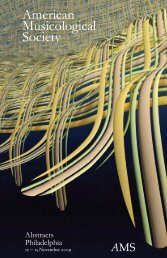Abstracts - American Musicological Society
Abstracts - American Musicological Society
Abstracts - American Musicological Society
You also want an ePaper? Increase the reach of your titles
YUMPU automatically turns print PDFs into web optimized ePapers that Google loves.
12 Thursday Morning: Session 1- 10<br />
AMS/SEM/SMT New Orleans 2012<br />
Session 1-10 (SEM), 8:30–10:30<br />
Studies of Musics in World History<br />
Barbara Hampton (Hunter College, City University of New York), Chair<br />
Flowers, Butterflies, Music, Death: The Extended Meanings of Floral Imagery in Nahua Songs<br />
Kristina Nielsen (University of California, Los Angeles)<br />
Pre-Columbian Nahua musical texts are rich in their use of deeply spiritual representations employing worldly imagery<br />
and metonymy, such as that of flowers and butterflies, to embody both music and the dead. While the metonymy of flowers<br />
and music is well documented (Tomilson), other appearances of flowers in Nahua literature are worthy of further exploration.<br />
Pre-Columbian Nahua poetry, such as Nezhualcoyotl’s, implies additional meanings in its use of floral imagery. These poems<br />
include lines such as, “like a painting we will be erased-like a flower we will dry up” that demonstrate significance beyond the<br />
well-established metonymy (trans. Leon-Portilla). Since these poems were often performed to music, I argue that they serve as<br />
a further extension of the meaning attributed to flowers in their metonymical relationship with music. Additionally, I explore<br />
the use of floral imagery in Nahua music and its representation of life and death in songs and poetry. This complex symbolic<br />
representation related life, song, flowers, and the dead, as music called the deceased residing in Tonatiuhican back to earth as<br />
butterflies and hummingbirds. The relationship between flowers and songs extended beyond metonymy into other facets of<br />
Nahua beliefs, as flowers are employed in representations of both the fleeting nature of life as well as the eminency of death.<br />
Through investigation of floral imagery and music, elements of the pre-Columbian Nahua understanding of life and the afterlife<br />
become apparent and provide new insight into the construction of the Nahua’s cosmos.<br />
The Death of Captain Cook: Native Hawaiians and their Simulacra<br />
in a Late-Eighteenth Century Pantomime<br />
James Revell Carr (University of North Carolina, Greensboro)<br />
The expeditions of Captain James Cook (1768–79) sparked the imagination of the European and <strong>American</strong> publics. Audiences<br />
voraciously consumed books, broadsides, prints, and plays that glorified Cook’s exploits in the Pacific and his dramatic<br />
death in Hawai‘i. Popular theatrical spectacles of the time capitalized on the public’s interest in maritime exploration, resulting<br />
in a new form of pantomime called ballet d’action, which purported to present “authentic” rituals, modes of warfare, music<br />
and dances of non-Western cultures. La Mort du Capitaine Cook (The Death of Captain Cook) was among the most popular of<br />
these pantomimes, featuring a score that called for the use of log drums and nose flutes, and costumes based in ethnographic<br />
drawings from the Cook expeditions, all intended to present audiences with new heights of realism and verisimilitude. Shortly<br />
after its 1788 premiere at Theatre de L’Ambigu-Comique in Paris, The Death of Captain Cook became an overnight sensation<br />
at Covent-Garden in London, and was soon exported to theaters throughout the young United States, marking the first representations<br />
of Hawaiian music and dance on <strong>American</strong> popular stages. This burlesque of Hawaiian culture was simultaneously<br />
legitimized and challenged when actual native Hawaiians, who worked aboard <strong>American</strong> merchant ships, were featured<br />
in performances in Boston and New York. I examine how Hawaiians, surrounded by the stagecraft of fake palm trees and<br />
volcanoes, embodied Western fantasies of the exotic while also exposing the artifice of staged mimesis through their own<br />
performance of authenticity.<br />
Dances with Samurai: Mimesis, Alterity, and the Tokugawa<br />
Roots of Blackface in Japanese Popular Culture<br />
Richard Miller (University of Wisconsin-Madison)<br />
When Commodore Mathew Calbraith Perry arrived off the coast of Shimonoseki, Japan in 1853 with the self-imposed<br />
mission to “open up” Japan to trade with the United States, he brought along gifts he hoped would awe the Japanese authorities<br />
and delight the Japanese people: a complete set of Audubon’s Birds of America, a miniaturized but working steam train,<br />
modern naval ships and weaponry, and all the pageantry soldier, sailors, marines, and three bass bands could muster. In doing<br />
this, Perry consciously mimicked the stereotype of an “oriental potentate.” However, Perry also brought a different kind of<br />
mimetic practice to Japan, a blackface minstrel troupe, the Original Ethiopian Olio Minstrels. Perry’s compatriots remarked<br />
in their journals how immediately and completely blackface performances were enjoyed by Japanese audiences in spite of their<br />
complete lack of experience with <strong>American</strong> stereotypes of Black slaves and freemen or the white cultural productions being<br />
parodied—not to mention the English language of the dialog. Unbeknownst to Perry and his crew, Japanese were prepared<br />
to appreciate blackface with a long tradition of mimetic othering of their own: Kankan odor, a carnivalesque caricaturing of<br />
foreigners drawing from public memories of embassies from China, Korea, Okinawa, and the Dutch East Indies enclave in<br />
Nagasaki. This paper examines the structural and performative homologies between Kankan odor and blackface minstrelsy,










